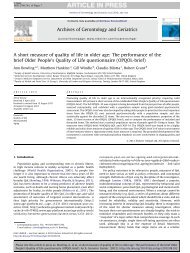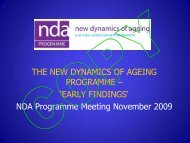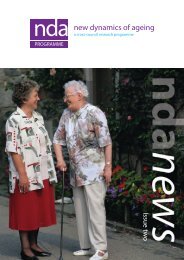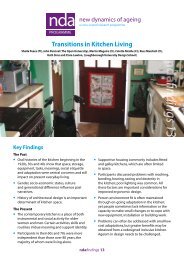Bagley, MC & Davis, T - New Dynamics of Ageing
Bagley, MC & Davis, T - New Dynamics of Ageing
Bagley, MC & Davis, T - New Dynamics of Ageing
You also want an ePaper? Increase the reach of your titles
YUMPU automatically turns print PDFs into web optimized ePapers that Google loves.
School <strong>of</strong> ChemistryOverview <strong>of</strong> TalkThe <strong>New</strong> Science <strong>of</strong> <strong>Ageing</strong>:A combined genetic and small moleculeapproach1. Introduction – general background and biology2. Interdisiplinarity – biology, chemistry, social science3. Project Goals – dissection <strong>of</strong> stress-induced cell ageing4. Results & Discussion – current outputs and problems5. Conclusions – Werner syndrome? The future?3
School <strong>of</strong> ChemistryIntroduction – the ageing story so far1) Life expectancy in the UK increased greatly over 20 th century. This isa great success story and is due to improved living conditions, publichealth and biomedicineAn individual living today who is 65 has a significantly greater remaininglife expectancy than if they had reached that birthday ten or twenty yearsago2) This “success” brings many challenges as not all individuals show“successful ageing” – and there is a large increase in age-related diseasee.g. strokes, macular degeneration, heart disease, and othersThese are <strong>of</strong>ten chronic and withoutcure resulting in a significant social andhealthcare cost (morbidity) – whatbiogerontology calls reduced“healthspan”morbidity4age
School <strong>of</strong> ChemistryIncrease health-span not just lifespanacb6Output Item: The contribution <strong>of</strong> Biogerontology to quality ageing : <strong>Bagley</strong> M., <strong>Davis</strong> T., Latimer J. andKipling D. (2011), Quality in <strong>Ageing</strong> and Older Adults. 12(1): 26-32
School <strong>of</strong> ChemistryPeer-reviewed articleThe contribution <strong>of</strong> biogerontology to quality ageingMark C <strong>Bagley</strong>Reader in Organic Chemistry, School <strong>of</strong> Chemistry, Cardiff University, UKTerence <strong>Davis</strong>Senior Research Fellow, School <strong>of</strong> Medicine, Cardiff University, UKJoanna LatimerPr<strong>of</strong>essor <strong>of</strong> Sociology, School <strong>of</strong> Social Sciences, and ESRC Centre for theEconomic and Social Aspects <strong>of</strong> Genomics, Cardiff University, UKDavid KiplingPr<strong>of</strong>essor <strong>of</strong> Biological Gerontology, School <strong>of</strong> Medicine, Cardiff University, UKPresentation at the UnitedNations International Day <strong>of</strong>Older People „Promoting Activeand Healthy <strong>Ageing</strong>’Conference. Temple <strong>of</strong> Peace,Cardiff, Wales 2010Quality in <strong>Ageing</strong> and Older Adults 2011, 12, 26-32.Copies available7
School <strong>of</strong> ChemistryWhat do we know about human ageing?<strong>Ageing</strong>:The universal, progressive, and intrinsicaccumulation <strong>of</strong> deleterious changes.Why are we bothered about ageing?The physiological effectiveness <strong>of</strong> anorganism is compromised, ultimately leadingto death.What causes it?UnknownHow can we understand it?Model species vs. human genetic diseasesUniversal vs. species-specific
School <strong>of</strong> ChemistryWerner Syndrome
School <strong>of</strong> ChemistryWerner SyndromeCharles W. Otto Werner, German physician(1879–1936)Rare, autosomal recessive genetic diseasePremature ageing <strong>of</strong> a subset <strong>of</strong> tissuesFeatures include: osteoporosis, bilateralcataracts, type II diabetes, thymic atrophy,an overall aged appearanceElevated risk <strong>of</strong> atherosclerosis andpredominantly mesenchymal cancersAffected tissues are mainly those containingcells that are division-competent during lifeThus may be due to accelerated cell ageingGeorge Martin and GermanWerner individual (age 36)American Werner syndromeindividual (age ~50)
School <strong>of</strong> ChemistryCell ageing – a possible mechanismFinite lifespan <strong>of</strong> normal human cellsin culture – divide ~50 timesSenescence– is viable cell cycle arrest– may act as a barrier to cancerformationSenescent cells– remain metabolically active– display altered patterns <strong>of</strong>gene expression, includingsecreted proteins
School <strong>of</strong> ChemistrySenescence as an <strong>Ageing</strong> MechanismPhysiological cell loss(wear-and-tear, wounding, haemodynamic stress)Standard cellsReplacement cell divisionProgressive accumulation <strong>of</strong> senescent cellsYoung humanfibroblastsSenescentmorphologyAltered cellularmicroenvironmentReduced divisioncapacity12Aged tissue
School <strong>of</strong> ChemistrySenescence as an <strong>Ageing</strong> MechanismPhysiological cell loss(wear-and-tear, wounding, haemodynamic stress)Young humanfibroblastsSenescentmorphologyReplacement cell divisionProgressive accumulation <strong>of</strong> senescent cellsWS cellsAltered cellularmicroenvironmentReduced divisioncapacity13Accelerated <strong>Ageing</strong>Kipling et al. Science 2004, 305, 1426-31
School <strong>of</strong> ChemistrySenescence as an <strong>Ageing</strong> Mechanism• WS cells in culture have a shortenedreplicative lifespan• They show slow growth rate,elongated cell cycle and sensescentmorphology <strong>of</strong> aged normalfibroblastsYoung humanfibroblastsSenescentmorphology• They enter senescence prematurelyafter only 15-20 PDWS cellsAltered cellularmicroenvironmentReduced divisioncapacity14Accelerated <strong>Ageing</strong>Kipling et al. Science 2004, 305, 1426-31
Preventing accelerated WS cell ageingJ. Gerontol. 2005, 60A, 1386.SB20358015Output Item: Use <strong>of</strong> p38 MAPK inhibitors for thetreatment <strong>of</strong> Werner syndrome, <strong>Bagley</strong>, M. C.; <strong>Davis</strong>,T.; Murziani, P. G. S.; Widdowson, C. S.; Kipling, D.Pharmaceuticals 2010, 3, 1842.
School <strong>of</strong> ChemistryTreating age-related diseases with p38 inhibitors16Relevance to normal ageingThere are environmental and clinicalfactors (such as cancer, infection,periodontal disease, stress) that canactivate p38 in normal individuals.This could link extrinsic lifecoursefactors with a fundamentalmechanism <strong>of</strong> ageingProblems using p38 inhibitorsp38 a major cellular signalling ‘hub’and regulates a very large number <strong>of</strong>downstream pathways.Its nodal role perhaps explainstoxicity/side effect issuesp38 inhibitors not specific enough
School <strong>of</strong> ChemistryOverview <strong>of</strong> TalkThe <strong>New</strong> Science <strong>of</strong> <strong>Ageing</strong>:A combined genetic and small moleculeapproach1. Introduction – general background and biology2. Interdisiplinarity – biology, chemistry social science3. Project Goals – dissection <strong>of</strong> stress-induced cell ageing4. Results & Discussion – current outputs and problems5. Conclusions – Werner syndrome? The future?17
School <strong>of</strong> ChemistryPr<strong>of</strong> David KiplingSchool <strong>of</strong> MedicineThe TeamDNA DamageDr Mark C <strong>Bagley</strong>School <strong>of</strong> ChemistryCellbiologyChemistryDr Terry <strong>Davis</strong>School <strong>of</strong> MedicineCellbiology<strong>Ageing</strong>Pr<strong>of</strong> Joanna LatimerSchool <strong>of</strong> Social Science<strong>Ageing</strong>-related diseaseintervention18<strong>Ageing</strong> therapeuticsSocialimplications
School <strong>of</strong> ChemistryWhat Use is Chemistry to Clinical Medicine?DrugDiscoverySynthesis andscreeningDiseasePathophysiologychemogenomics19
Example: BIRB 796 p38 Inhibitor Synthesis20<strong>Bagley</strong>, M. C.; <strong>Davis</strong>, T.; Dix, M. C.; Widdowson, C. S.; Kipling, D. Org. Biomol. Chem. 2006, 4, 4158.
School <strong>of</strong> ChemistryComparing different p38 inhibitorsSCIBS initiativeVX-745RO3201195BIRB 796UR-1375621All synthesized by the <strong>Bagley</strong> team.
School <strong>of</strong> ChemistryOverview <strong>of</strong> TalkThe <strong>New</strong> Science <strong>of</strong> <strong>Ageing</strong>:A combined genetic and small moleculeapproach1. Introduction – general background and biology2. Interdisiplinarity – biology, chemistry social science3. Project Goals – dissection <strong>of</strong> stress-induced cell ageing4. Results & Discussion – current outputs and problems5. Conclusions – Werner syndrome? The future?22
School <strong>of</strong> ChemistryStress-induced Cell Growth ArrestEnvironmental stressDNA replication stressWernersyndromeStress LoadPremature ageing is consistent withaccelerated replicative senescencedue to endogenous stressp38a MAPKMK2/323Cell cycle arrestChronic illnessPro-inflammatorycytokinebiosynthesis
School <strong>of</strong> ChemistryScientific RationaleEnvironmental stressDNA replication stressWernersyndromeStress Loadp38a MAPKINHIBITORSMK2/3Selection Criteria :• Efficacy• Kinase selectivity• Cellular potency• Mammalian model24Cell cycle arrestChronic illnessPro-inflammatorycytokinebiosynthesis
School <strong>of</strong> ChemistryConfirming the role <strong>of</strong> p38a signallingVX-745DNA replication stressStress LoadUR13756JNKVX-745UR13756p38a MAPKMK2/325Growth arrestGrowth arrest
School <strong>of</strong> ChemistrySelectivity <strong>of</strong> p38a kinase inhibitorsBIRB 796DNA replication stressStress LoadJNKBIRB 796SB203580p38a MAPKSB203580MK2/3Data suggestsinvolvement <strong>of</strong> JNK26Growth arrestGrowth arrest
School <strong>of</strong> ChemistryOverview <strong>of</strong> TalkThe <strong>New</strong> Science <strong>of</strong> <strong>Ageing</strong>:A combined genetic and small moleculeapproach1. Introduction – general background and biology2. Interdisiplinarity – biology,chemistry social science3. Project Goals – dissection <strong>of</strong> stress-induced cell ageing4. Results & Discussion – current outputs and problems5. Conclusions – Werner syndrome? The future?27
School <strong>of</strong> ChemistryThe effect <strong>of</strong> JNK inhibitorsPrevious data suggested possible role for JNK activityThus synthesized JNK inhibitorsThis data points finger at MK2Output item28Effects <strong>of</strong> diaminopyridine inhibitors on the growth and morphology <strong>of</strong> Werner syndrome fibroblasts.<strong>Davis</strong>, T.; Kipling, D.; <strong>Bagley</strong>, M.C.; et al. Chem. Cent. J. 2011, 5, in review.
School <strong>of</strong> ChemistryMK2 – a new target??DNA replication stressStress LoadMK2 inhibitorsp38a MAPKMK2/329Growth arrestKey Biological Hypotheses:Does MK2 inhibition ameliorate the slowgrowth in WS cells?Does MK2 inhibition modulate senescenceresulting from oxidative stress?
School <strong>of</strong> ChemistryMK2 Inhibitors in WS cells• CMPD 2 confirmed as MK2 inhibitor• Little effect on growth rate at 2.5 mM(which is less than [IC50])• Cells undergo a dramaticmorphological change at 10 mM30<strong>Davis</strong>, T.; <strong>Bagley</strong>, M. C.; Murziani, P.; Rokicki, M.; Widdowson, C.S.; Zayed, J. M.; Bachler, M. A.; Kipling, D.Bioorg. Med. Chem. Lett. 2007, 17, 6832–6835.
School <strong>of</strong> ChemistryMK2 Inhibitors in WS cellsKey Biological Hypotheses:Does MK2 inhibition ameliorate the slow growth in WS cells?Does MK2 inhibition modulate senescence resulting from oxidative stress?....could not be studied using existing chemical toolsAssemble more recently disclosed inhibitors <strong>of</strong> MK2 as chemical tools forstudy <strong>of</strong> the WS phenotype:Problem: NO CHEMIST31<strong>Davis</strong>, T.; <strong>Bagley</strong>, M. C.; Murziani, P.; Rokicki, M.; Widdowson, C.S.; Zayed, J. M.; Bachler, M. A.; Kipling, D.Bioorg. Med. Chem. Lett. 2007, 17, 6832–6835.
School <strong>of</strong> ChemistrySocial issues with “extended life”?“(normal) ageing is a disease” – misfit between biomedical and regulatoryfunding structures and anti-ageing science – forcing ageing to be renamed asdisease?Tensions between:Postponing those ageing effects that are correlated with disabling diseases <strong>of</strong>later life, while at the same supporting and valuing older people.Prolongevity (the immortalists) movement & adding quality <strong>of</strong> life to yearsmovement.Social, cultural and ethical aspects <strong>of</strong> anti-ageing scienceand medicine (Qualitative evidence: Joanna Latimer)32• Interviews, discussions and site visits with ageing scientists;• Analysis <strong>of</strong> the literature (scientific and social studies);• Interviews and discussions with skeptics <strong>of</strong> ageing science.
School <strong>of</strong> ChemistrySocial issues with “extended life”?• Discusses how ageism is endemic to some aspects <strong>of</strong> health care andmedicine.• Explores how biogerontology could contribute to the social inclusion <strong>of</strong>older people, particularly in relation to health care.• Defining the ways that biogerontology is reconceptualising what it is to age,and to be old, can help reinclude ageing and the aged in health careeducation, policy and practice.33Output item<strong>Ageing</strong> science, health care and social inclusion <strong>of</strong> older people.Latimer J., <strong>Bagley</strong> M., <strong>Davis</strong> T. and Kipling D. Quality in <strong>Ageing</strong> & Older Adults(2011), 12(1):11-16.
School <strong>of</strong> ChemistryPeer-reviewed article<strong>Ageing</strong> science, health care and social inclusion <strong>of</strong> olderpeopleJoanna LatimerPr<strong>of</strong>essor <strong>of</strong> Sociology, School <strong>of</strong> Social Sciences, and ESRC Centre for theEconomic and Social Aspects<strong>of</strong> Genomics, Cardiff University, UKTerence <strong>Davis</strong>Senior Research Fellow, School <strong>of</strong> Medicine, Cardiff University, UKMark C <strong>Bagley</strong>Reader in Organic Chemistry, School <strong>of</strong> Chemistry, Cardiff University, UKDavid KiplingPr<strong>of</strong>essor <strong>of</strong> Biological Gerontology, School <strong>of</strong> Medicine, Cardiff University, UKQuality in <strong>Ageing</strong> and Older Adults 2011, 12, 11-16.Presentation at the UnitedNations International Day <strong>of</strong>Older People „Promoting Activeand Healthy <strong>Ageing</strong>’Conference. Temple <strong>of</strong> Peace,Cardiff, Wales 2010Copies available34
School <strong>of</strong> ChemistrySummary <strong>of</strong> output items to dateJournal PublicationsOutput 1: Use <strong>of</strong> p38 MAPK inhibitors for the treatment <strong>of</strong> Werner syndrome,<strong>Bagley</strong> <strong>MC</strong>, <strong>Davis</strong> T, Murziani PGS, Widdowson CS, Kipling D. Pharmaceuticals(2010), 3:1842-1872.Output 2: The contribution <strong>of</strong> biogerontology to quality ageing.<strong>Bagley</strong> <strong>MC</strong>, <strong>Davis</strong> T, Latimer J, Kipling D. Quality in <strong>Ageing</strong> & Older Adults (2011),12(1):26-32.Output 3: <strong>Ageing</strong> science, health care and social inclusion <strong>of</strong> older people.Latimer J, <strong>Bagley</strong> <strong>MC</strong>, <strong>Davis</strong> T, Kipling D. Quality in <strong>Ageing</strong> & Older Adults (2011),12(1):11-16.Output 4: Effects <strong>of</strong> diaminopyridine inhibitors on the growth and morphology<strong>of</strong> Werner syndrome fibroblasts.<strong>Davis</strong> T, Dix <strong>MC</strong>, Rokicki MJ, Brook AJC, Kipling D, <strong>Bagley</strong> <strong>MC</strong>. Chem. Cent. J.(2011), 5: in review.35
School <strong>of</strong> ChemistryOverview <strong>of</strong> TalkThe <strong>New</strong> Science <strong>of</strong> <strong>Ageing</strong>:A combined genetic and small moleculeapproach1. Introduction – general background and biology2. Interdisiplinarity – biology,chemistry social science3. Project Goals – dissection <strong>of</strong> stress-induced cell ageing4. Results & Discussion – current outputs and problems5. Conclusions – Werner syndrome? The future?36
School <strong>of</strong> ChemistryIs there a link between stress and ageing?Can we intervene in ageing in WS?Yes!Will this lead to a clinical treatment?Maybe…..Can we intervene in the otherclinical symptoms <strong>of</strong> this syndrome?Maybe…..Can we intervene in ageing in you and I?No not yet, but we have good evidencethat the senescence <strong>of</strong> somatic cells is acausal agent <strong>of</strong> normal ageing and thatthis could be prevented with smallmolecule inhibitors37
School <strong>of</strong> ChemistryZoomer Nation – a new ageing visionMoses Znaimerhttp://www.zoomermag.com/tag/moses-znaimer• promotes a positive vision <strong>of</strong> elderly people• fights for elderly peoples‟ rights• elderly people contributing to the economy <strong>of</strong> allrather than simply “recipients” <strong>of</strong> Healthcare• promotes social inclusion by highlightingbenefits rather than problemsA new vision <strong>of</strong>ageing Canada38http://www.carp.ca/2011/10/21/the-future-<strong>of</strong>-ageing/
School <strong>of</strong> ChemistryAcknowledgementsPeopleFundingDr Matt Dix BBSRCDr Caz Widdowson EPSRCDr Paola Murziani SPARCMr Michal Rokicki BBSRC, ESRC(NDA)Ms Leanne Walker ESRC(NDA)BBSRC Anglo-Japanese Partnering AwardWellcome TrustThe Nuffield FoundationThe Royal Society39








